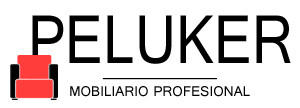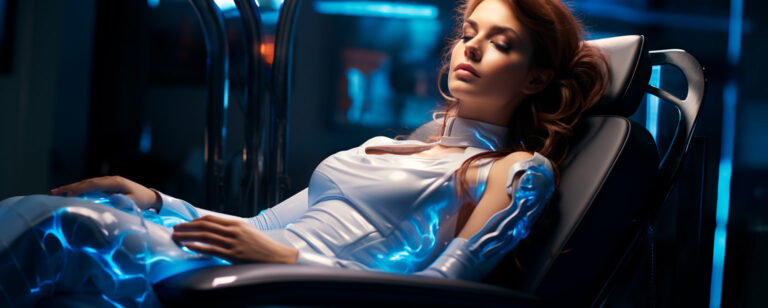Pressotherapy is a non-invasive aesthetic treatment that uses water pressure to improve various circulatory and aesthetic problems such as fluid retention and cellulite. It is a painless technique that is performed using an aesthetic equipment called pressotherapy, which emits pressurized water jets on the area to be treated.
What does pressotherapy consist of?
Pressotherapy consists of applying gentle pressure exerted by water on the body. This pressure acts from inside to outside of the tissues, improving blood and lymphatic circulation.
The pressotherapy equipment consists of a compressor that drives the water and a hose with several jets that adapt to different areas of the body. The water pressure can be adjusted, being more intense the deeper the treated area is.
The water jets perform a massage that activates circulation and helps eliminate fluids and toxins. This way, cellulite and fluid retention are combated, and the sensation of tired legs is relieved.
Benefits of pressotherapy
- Improves blood and lymphatic circulation
- Reduces fluid retention
- Decreases cellulite
- Relieves sensation of heaviness
- Tones the skin
- Stimulates toxin elimination
- Reduces the appearance of varicose veins and spider veins
- Combats flaccidity and improves skin appearance
Pressotherapy for fluid retention
Fluid retention is an excessive accumulation of fluid in the body. It occurs due to poor circulation or hormonal imbalance.
Its most common symptoms are swelling in legs, ankles, arms, and abdomen, sensation of heaviness and discomfort, and increased clothing size.
Pressotherapy helps combat fluid retention by:
- Improving lymphatic drainage
- Activating blood circulation
- Reducing capillary permeability and fragility
- Balancing tissue pressure
- Decongesting tired legs
With pressotherapy, return circulation is activated, eliminating excess fluid accumulated in the tissues. Legs deflate, decrease in volume, and the sensation of heaviness is relieved.
Pressotherapy for cellulite
Cellulite is the accumulation of fat and fluid retention that gives the skin an “orange peel” appearance. It appears mainly on buttocks, hips, and thighs.
It is an effective treatment against cellulite because:
- It improves the circulatory and lymphatic system
- Reduces fat deposits
- Decreases fluid retention
- Tones the skin and deeply hydrates it
- Stimulates collagen and elastin production
The water pressure waves improve microcirculation, activate toxin elimination, mobilize fat, and drain stagnant fluids.
As a result, the skin is firmer and the appearance of cellulite noticeably decreases.
How is a pressotherapy treatment?
Pressotherapy is performed through sessions at a beauty center with staff specialized in this treatment.
- First, you put on a mesh or neoprene suit to receive the water jets.
- Then, the pressotherapy hose is placed adapted to the area to be treated (legs, buttocks, abdomen, arms…).
- The specialist adjusts the intensity and path of the water jets. The pressure will be greater the deeper the area.
- The session lasts between 30-60 minutes depending on the extent to be treated. A continuous jet is applied in a spiral shape that goes up and down the area.
- Pressotherapy is performed with the person lying down or sitting, in a comfortable and relaxed position.
- Sessions are repeated 2-3 times a week, with 10-15 sessions recommended to see results.
- Pressotherapy doesn’t hurt, you simply feel an invigorating pressure from the water massage.
- After the session, the skin may have a slight redness that disappears quickly.
Results of pressotherapy
The results of pressotherapy on fluid retention and cellulite start to be noticed after the first sessions:
- The skin is firmer, smoother, and more hydrated.
- The “orange peel” appearance visibly decreases.
- Inflammation and volume in legs and treated areas are reduced.
- Varicose veins and spider veins are attenuated.
- Toxins are eliminated and cellulite begins to disappear.
- Pressotherapy tones, firms, and stimulates cell regeneration.
To achieve lasting results, it’s recommended to take maintenance sessions, as well as maintain a healthy diet and exercise regularly.
Contraindications of pressotherapy
It is not advised in the following cases:
- Pregnancy and breastfeeding
- Cancer
- Tumors
- Thrombosis
- Severe uncontrolled hypertension
- Severe varicose veins
- Sensitive skin or with wounds
- Recent sunburns
- Infections
It’s important to consult a doctor before undergoing a treatment. The specialist will evaluate if there are specific contraindications for each person.
Pressotherapy vs Mesotherapy: which is better for cellulite?
Mesotherapy consists of injecting microdoses of drugs, vitamins, and minerals into the area with cellulite. Both treatments are effective but with some differences:
- Pressotherapy is painless, mesotherapy hurts a bit due to injections.
- Pressotherapy is non-invasive, mesotherapy involves substance injection.
- Pressotherapy has fewer contraindications than mesotherapy.
- Mesotherapy can cause bruising, pressotherapy does not.
- Pressotherapy requires several sessions, mesotherapy needs fewer.
- The results of both are good, but can be better when combining the two.
In general, pressotherapy is preferable for people with mild to moderate cellulite and fear of needles. Mesotherapy is recommended for stubborn cellulite or very advanced cases.
Price
The price can vary between 30-80 € per session, depending on the area to be treated and the prestige of the beauty center.
Sessions are usually sold in packages of 10-15 sessions, with an approximate total cost of:
- Full legs: from 300 € to 600 €
- Buttocks and hips: from 400 € to 800 €
- Abdomen: from 250 € to 500 €
- Arms: from 200 € to 400 €
Many centers offer the first session for free for customers to try. There are also offers and discounts when buying large session packages.
Tips to make the most of it
To maximize results in fluid retention and cellulite, it’s recommended to:
- Drink plenty of water before and after treatment to promote drainage.
- Drink purifying infusions that help eliminate fluids.
- Don’t apply creams before the session for better water absorption.
- Complement the treatment with exfoliation, massage, or radiofrequency.
- Take care of your diet, avoiding excesses of salt, sugar, and alcohol.
- Don’t cross your legs during sessions.
- Walk after treatment to activate circulation.
- Perform some physical activity regularly.
- Use compression stockings after each session.
Contraindications and warnings
- Not recommended for pregnant women or during breastfeeding. Consult a doctor beforehand.
- People with severe varicose veins or thrombosis should avoid this treatment.
- Pressotherapy may not be suitable if you suffer from serious heart diseases.
- Oncological patients should consult their doctor beforehand.
- This treatment should be avoided if you suffer from uncontrolled high blood pressure.
- Avoid its application on areas of skin with wounds, burns, or infections.
- A slight skin pigmentation after the session is normal and disappears within a few hours.
- Go to a medical center if bruises, intense pain, or allergic reactions occur after the session.
Frequently asked questions
From what age can it be done?
It can be performed at any age, even in young people from 16-18 years old. The important thing is not to have medical contraindications.
Can pressotherapy be done during menstruation?
Yes, it can be done, in fact many women notice relief from premenstrual pain. The ideal is to use a special belt for pressotherapy during those days.
How long does a pressotherapy session last?
The session usually lasts between 30-60 minutes depending on the area to be treated. Full legs normally require 60 minutes.
How often can sessions be repeated?
The recommended frequency is 2 to 3 sessions per week. A rest day should be left between sessions.
Can you go to work after pressotherapy?
Yes, it does not prevent performing daily activities normally right after.
Is pressotherapy or mesotherapy better?
Both are complementary, pressotherapy is preferred as initial treatment because it’s painless. If it’s not enough, it can be combined with mesotherapy.
Can pressotherapy and radiofrequency sessions be combined?
Yes, in fact it’s highly recommended to combine pressotherapy and radiofrequency to enhance results against cellulite.
Does pressotherapy help with weight loss or size reduction?
Not directly, but by reducing fluid retention and reducing centimeters, less volume and more fitted sizes can be noticed.
Is it normal to have bruises after pressotherapy?
It’s not common, bruises may indicate that the water pressure is being excessive for your capillaries. You should communicate this to the specialist.
Who cannot undergo a pressotherapy treatment?
It’s contraindicated for pregnant women, patients with thrombosis, severe varicose veins, uncontrolled hypertension, heart diseases, cancer patients, and very sensitive skin.



